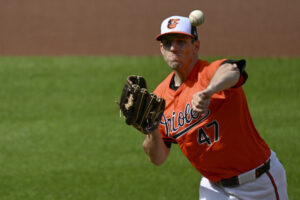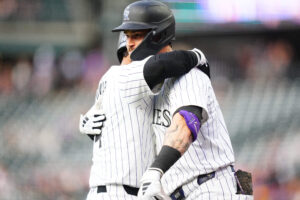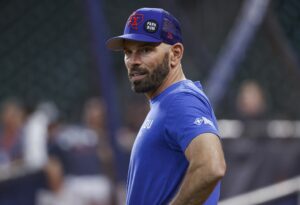Throughout history, there has been many great teams in baseball. For example, you have the 1927 Yankees, nicknamed “Murderer’s Row”. You have the 1998 Yankees as well, but one team stands out in the annals of baseball lore, and that’s the “Big Red Machine”.
Reliving History: The 1976 Cincinnati Reds
The 1976 Reds, better known as the “Big Red Machine” is one of the best teams of all time. With a starting lineup dubbed “The Great 8”, they hit, a lot and they pitched very well to boot. This team didn’t just grow overnight though as it was fate that brought this team together, even after the most egregious trade in baseball history. first, let’s look at that.
The year is 1965, and Frank Robinson is fresh off his year 30-year-old season, and an NL MVP. Cincinnati owner Bill Dewitt sought after the one thing the Reds didn’t have, pitching. The Cincinnati Reds led the league in offense and defense but was at the bottom of the pitching totem pole. So, in lieu of needing that pitching, Dewitt shipped out his 30-year old outfielder to the Baltimore Orioles. In return, the Reds received Milt Pappas, Jack Baldschun, and Dick Simpson in a trade widely known as the worst trade in baseball history.
Pappas had been very good with Baltimore, racking up a 2.60 ERA and a 7.3 fWAR. It was easy to see why Dewitt executed the trade. He believed that Pappas could be the Mat Latos to Johnny Cueto, except Cueto in this situation was Jim Maloney. Latos and Pappas actually have very comparable stats as well. As the Reds would soon find out, that trade didn’t pan out, at all. Pappas was not good as a Red and Robinson went on to win the Triple Crown, AL MVP, and a World Series title with the Orioles.
The Baseball Gods’ Second Chance
Even after that terrible trade, the baseball gods decided to give Cincinnati a second chance. They already had Pete Rose, baseball’s hit king, Tony Perez, and Johnny Bench. What they needed now were a few more pieces and the empire would be complete. As the team broke into the ’70s, they were determined to win. They did so by winning the division and sweeping the Pittsburgh Pirates in three games and making the World Series. Unfortunately, Robinson and the Orioles were waiting and defeated them 4-1 in the series.
It is important to note that the Reds had added their Hall of Fame manager already in Sparky Anderson. They won 102 games in 1970, and acquired back end bullpen piece, Pedro Borbon, and also shipped out the aforementioned Jim Maloney. Then, after finishing under .500 in ’71, Cincinnati started to make its move towards the top. In November of ’71, they shipped out mainstays of the lineup in Tommy Helms and Lee May and also Jimmy Stewart to the Houston Astros. In return, they received more pieces that would make them a top team. They receive pitchers Ed Armbrister and Jack Billingham, along with Center Fielder Cesar Geronimo, Second Baseman Joe Morgan, and utility man Denis Menke.
After that huge trade, the Reds were starting to see their dream team take place. In 1972, they finished in 1st place again winning 95 games, and defeated Pittsburgh, again, 3 games to 2. They would lose to the Oakland A’s in the World Series in 7 games that year, but this team wasn’t done. They added another pitcher in Fred Norman in June of ’73 on their way to another division title. This time the Reds would be thwarted by the New York Mets in the NLCS, a series that was nasty and gritty, highlighted by Pete Rose’s brawl with Mets’ shortstop Bud Harrelson.
The Time Has Come
After adding franchise legend Mario Soto in December of ’77, the Reds were ready to run it back, winning 98 games in 1974, unfortunately missing the playoffs in a rare occurrence where a team who won that many games missed out on the postseason. In 1975, the Reds once again won the division, winning a whopping 108 games. They once again had a league MVP in Joe Morgan, to go along with Bench and Rose both winning the award respectively, in ’70 & ’72 and ’73. Morgan, who was included in the aforementioned trade with Houston, hit .327/.466/.508 with 17 homers and 94 RBI. He led the league in walks, OBP, OPS & OPS+. He also added in the go-ahead base hit in the decisive game of a wild 1975 World Series win over the “cursed” Boston Red Sox.
After years of heartbreak and wondering what could’ve been after the Robinson trade, they did it. The Reds finally were at the top of the mountain and it didn’t stop there. They had the best offense in the league and boasted four future Hall of Famers. With those four leading the way, and the rest of the cast being just as good, the Reds ran it back. 1976 was a magical year for Cincinnati. Seven of their eight starters hit .280 or higher, with six of them over .300 on the year. Joe Morgan collected his second straight MVP, giving the Reds five MVP winners in the decade up to this point.
In that magical 1976 season, the Big Red Machine, and the Great 8 ran roughshod through the competition en route to 102 wins. The Reds overwhelmed the Philadelphia Phillies in the NLCS, three games to none. Next was the Evil Empire, the New York Yankees. They were also overwhelmed by the greatness of this team and were swept in four games. This gave the Reds their second World Series title in as many years and cemented them as one of the best teams in baseball’s fabled history.
The End of a Great Run
The 1976 Cincinnati Reds were dominant, that much is true. This process wasn’t quick though. Although the Reds contended consistently, it wasn’t all daisies and rainbows. Bill Dewitt, the same man who traded Frank Robinson a decade earlier, redeemed himself. He proved himself masterful as he built a winner. The Reds had to wait until 1979 to make run again but were beaten by the eventual champion Pirates. The Big Red Machine then disbanded as quickly as it arrived. Rose left for Philly in ’79. Morgan was the same, heading back to Houston in 1980. Eventually, the only player left was Johnny Bench.
There is no doubt this team is one of the best in baseball history. Regularly, Reds fans hold this team close to their hearts for a good reason. They were the winningest team of the decade in the ’70s and boasted six MVPs in that span. Unfortunately, all good things must end eventually, which it did. That will never negate the sheer dominance of this team though. This is the Big Red Machine.
Main Image
Embed from Getty Images






